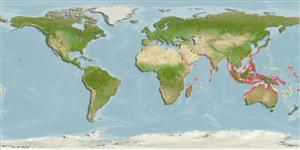Common names from other countries
>
Gobiiformes (Gobies) >
Gobiidae (Gobies) > Gobiinae
Etymology: Glossogobius: Greek, glossa = tongue + Latin, gobius = gudgeon (Ref. 45335).
More on author: Hamilton.
Environment: milieu / climate zone / depth range / distribution range
Οικολογία
Θαλασσινό(ά); Γλυκού νερού; Υφάλμυρο βενθοπελαγικό; αμφίδρομο (Ref. 51243); εύρος βάθους 0 - 5 m (Ref. 86942). Tropical; 25°C - ? (Ref. 2059); 30°N - 32°S, 25°E - 176°E
Africa to Oceania: Red Sea and East Africa, south to Transkei in South Africa, and most inland freshwater bodies over the Indian Ocean and western Pacific (Ref. 4343, 52193). Common in coastal and estuarine waters from austral Africa and Madagascar to India and south of China.
Length at first maturity / Μέγεθος / Βάρος / Age
Maturity: Lm ?, range 9 - ? cm
Max length : 50.0 cm SL αρσενικό/απροσδιόριστο; (Ref. 4967); common length : 11.3 cm SL αρσενικό/απροσδιόριστο; (Ref. 35840)
Ραχιαίες άκανθες (συνολικά) : 7; Μαλακές ραχιαίες ακτίνες (συνολικά) : 8 - 9; Εδρικές άκανθες: 1; Μαλακές εδρικές ακτίνες: 8 - 9.
Found mainly in freshwater and estuaries, but also enter the sea (Ref. 4833). Also occur in canals, ditches and ponds (Ref. 12693). Found in clear to turbid streams with rock, gravel or sand bottoms (Ref. 2847). Encountered in medium to large-sized rivers of the lower Mekong (Ref. 12975). Feed on small insects, crustaceans and small fish. Grow to a much larger size in brackish water than in fresh water. Marketed fresh (Ref. 12693). Cannibalism is relatively common for this species (Ref. 48660).
Life cycle and mating behavior
Maturities | Αναπαραγωγή | Spawnings | Egg(s) | Fecundities | Προνύμφες
Spawning occurs in freshwater afterwhich eggs and larvae are washed down by the river current into the sea (Ref. 110258).
Maugé, L.A., 1986. Gobiidae. p. 358-388. In J. Daget, J.-P. Gosse and D.F.E. Thys van den Audenaerde (eds.) Check-list of the freshwater fishes of Africa (CLOFFA). ISNB, Brussels; MRAC, Tervuren; and ORSTOM, Paris. Vol. 2. (Ref. 4343)
IUCN Red List Status (Ref. 130435)
CITES (Ref. 128078)
Not Evaluated
Threat to humans
Harmless
Human uses
αλιεία: περιορισμένης εμπορικότητας; Υδατοκαλλιέργειες: Εμπορικό(ά); Ενυδρείο: Εμπορικό(ά)
Εργαλεία
Special reports
Download XML
Διαδικτυακές πηγές
Estimates based on models
Preferred temperature (Ref.
115969): 25 - 29.3, mean 28.5 (based on 2836 cells).
Phylogenetic diversity index (Ref.
82804): PD
50 = 0.5000 [Uniqueness, from 0.5 = low to 2.0 = high].
Bayesian length-weight: a=0.00724 (0.00642 - 0.00818), b=3.07 (3.04 - 3.10), in cm Total Length, based on LWR estimates for this species (Ref.
93245).
Τροφικό Επίπεδο (Ref.
69278): 3.7 ±0.2 se; based on diet studies.
Ελαστικότητα (Ref.
120179): Υψηλό, ελάχιστος χρόνος για διπλασιασμό πληθυσμού < 15 μήνες (K=0.8; Fec=18,578;).
Fishing Vulnerability (Ref.
59153): Low to moderate vulnerability (26 of 100).
